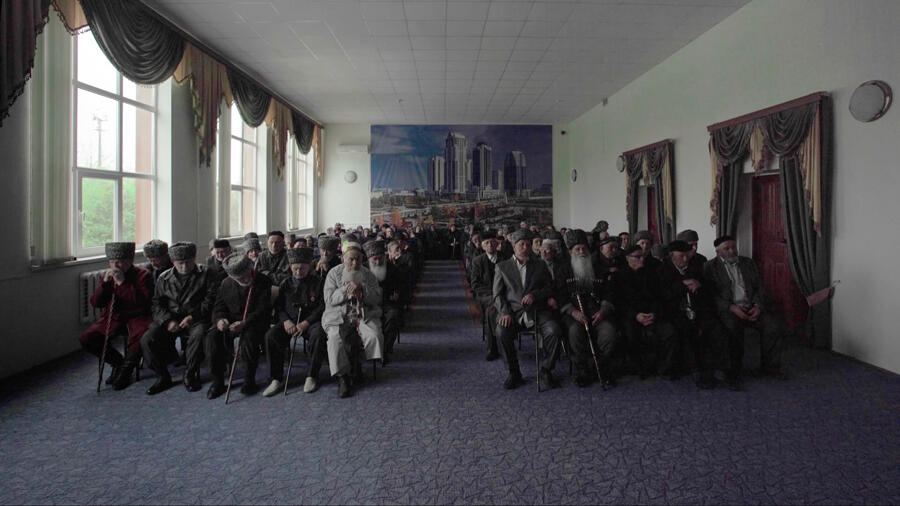Aslan Gaisumov’s Chechen Stories
Two films show ways of approaching and exorcizing the country's troubled past at Emalin, London, UK
Two films show ways of approaching and exorcizing the country's troubled past at Emalin, London, UK

A 4 x 4 snakes up a road, dwarfed between the mountains and expanse of sky. Save for occasional patches of greenery, there are no other signs of life. In the backseat sits a woman in her 90s, modestly dressed, her hair covered by a scarf, a string of prayer beads in her hand. As the vehicle continues through this desolate landscape, pangs of anxiety and recognition flash across her face, hints of tears in her eyes. Her name is Zayanu Khasueva and she is the artist's grandmother.

In Keicheyuhea (2017), one of two films that form 'All That You See Here, Forget', Aslan Gaisumov's first exhibition at Emalin, curated by Anna Smolak, the artist follows his grandmother as she returns for the first time in 73 years to the titular settlement in the Caucasus mountains that used to be her family's home. That is until the winter of 1944, when the entire Chechen and Ingush nations, some half a million people, were deported to Central Asia, accused by the Soviet state of collusion with Nazi Germany – a fact that is known but little discussed in official historical narratives.
For Gaisumov, who lives and works in the Chechen Republic's capital of Grozny, the unspeakable horrors of war have continuously seeped from life into art. His works to date, from one of his earliest pieces, 'Untitled (War)' (2008–17), to the more recent Volga (2015), have addressed the military conflict with Russia that tore apart the autonomous region during the 1990s and early 2000s, and testify to the struggle to find a visual language capable of representing personal and historical trauma. Installed back to back in the darkened gallery, Keicheyuhea and People of No Consequence (2016) offer complementary ways of approaching and exorcizing this past: as shared experience and personal story. If the former recuperates this memory from oblivion, the latter, as the exhibition's title suggests, stops it from becoming yet another statistic while also allowing a space for healing.

The personal demands an audible voice and in Keicheyuhea it is only Khasueva's that animates the film's 26 minutes, as she recalls snippets of the village's former way of life and the deaths of her two sisters during their arduous journey to Kazakhstan. Mourning often calls for silence: in People of No Consequence, the usual commemorative minute is prolonged to eight. Enough time for the rows of empty chairs in a municipal hall in Grozny to be filled by elderly men and women who slowly file in and take their seats facing the camera, the quiet occasionally interrupted by the shuffling of feet and the scraping of chairs. It is only once the room is full and the frame cuts to black that we learn their identities: survivors of the 1944 expulsions, brought together for the first time at the invitation of the artist.

Together, these works trigger painful questions of how these traumas sit within a wider national myth-making bent on exclusion. In a country where World War II is officially referred to as the Great Patriotic War and where its human sacrifice has been increasingly used by the current government to stoke the flames of patriotism, they ask: whose history? A giant poster of 21st-century Grozny, all gleaming skyscrapers, hangs behind the gathered witnesses in People of No Consequence: a reminder that multiple historical erasures are under way. Looked at from the position of today's geopolitics, where forced migration has become a ubiquitous newspaper headline and where histories can seemingly be rewritten on a whim, how do we maintain awareness? In their matter-of-fact directness, these two films steer clear of pathos to attain a measured dignity of their own: the most anti-monumental of memorials.
Main image: Aslan Gaisumov, Keicheyuhea, 2017, film still. Courtesy: the artist and Emalin, London
Keicheyuhea and People of No Consequence will be on show as part of the Liverpool Biennial 2018, UK, which runs from 14 July - 28 October.





















